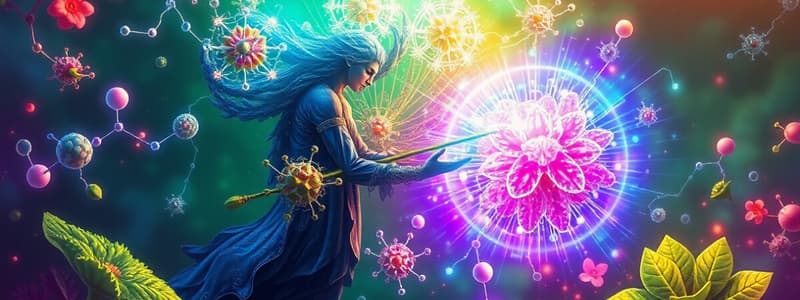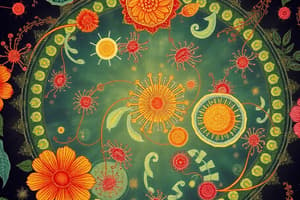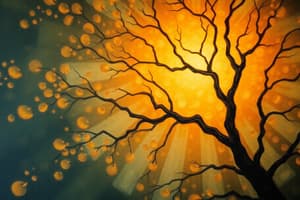Podcast
Questions and Answers
Considering the hierarchical organization of life, which of the following sequences represents an increasing order of complexity?
Considering the hierarchical organization of life, which of the following sequences represents an increasing order of complexity?
- Organelles, molecules, cells, tissues
- Molecules, atoms, organelles, tissues
- Tissues, cells, organelles, molecules
- Atoms, molecules, organelles, cells (correct)
Homeostasis is a crucial property of life. Which of the following best illustrates homeostasis in humans?
Homeostasis is a crucial property of life. Which of the following best illustrates homeostasis in humans?
- Increased sweating on a hot day to cool the body.
- Shivering when exposed to cold temperatures.
- Regulation of blood sugar levels after a meal.
- All of the above. (correct)
If a newly discovered single-celled organism demonstrates phototaxis, what can be inferred about its behavior?
If a newly discovered single-celled organism demonstrates phototaxis, what can be inferred about its behavior?
- It remains stationary when exposed to light.
- It is repelled by chemical stimuli.
- It moves towards or away from light sources. (correct)
- It moves randomly regardless of light exposure.
Four elements are most common in living organisms. If a scientist discovers a new organic molecule, which elements would always be present?
Four elements are most common in living organisms. If a scientist discovers a new organic molecule, which elements would always be present?
Considering the characteristics of life, which process primarily ensures the continuation of a species?
Considering the characteristics of life, which process primarily ensures the continuation of a species?
Flashcards
Biology
Biology
The science that studies living organisms and their interactions with each other and their environment.
Order (in organisms)
Order (in organisms)
Highly organized structures, even at the single-cell level, where atoms form molecules and molecules form organelles.
Sensitivity to stimuli
Sensitivity to stimuli
The ability of organisms to respond to diverse stimuli in their environment.
Reproduction
Reproduction
Signup and view all the flashcards
Common elements in living organisms
Common elements in living organisms
Signup and view all the flashcards
Study Notes
- Biology is the science that studies living organisms, their interactions with each other, and their environment.
- It attempts to describe and understand the nature of the universe.
- Biology encompasses many branches.
- All living organisms share key properties, including order, response to stimuli, reproduction, growth and development, regulation, homeostasis, energy processing, and adaptation.
Order
- Organisms are highly organized, even down to single-celled organisms.
- Inside each cell, atoms form molecules, and these molecules make organelles.
- In multicellular organisms, cells form tissues, tissues form organs, and organs form systems.
Sensitivity to Stimuli
- Organisms respond to diverse stimuli.
- Examples of responses include plants bending towards light, climbing fences or walls, or responding to touch.
- Bacteria can move towards or away from chemicals (chemotaxis) or light (phototaxis).
- Positive responses involve movement towards a stimulus.
- Negative responses involve movement away from a stimulus.
Reproduction
- Single-celled organisms reproduce by duplicating their DNA and then dividing it equally to form two new cells.
- Multicellular organisms reproduce by producing sex germline cells that will form new individuals.
- DNA contains genes that pass from parents to offspring.
- This ensures that offspring belong to the same species and share similar characteristics.
Growth & Development
- Genes in the DNA contain the instructions for growth and development in all organisms.
Regulation
- Regulation refers to the coordination of internal functions, such as nutrient transport, blood flow, waste removal, and body cooling.
Homeostasis
- Homeostasis is the ability of an organism to maintain constant internal conditions.
- Cells need to maintain optimal conditions like temperature, pH, and ion concentration for proper function.
- Organisms maintain internal conditions within a narrow range despite environmental changes.
- Organisms living in cold climates, like polar bears, have body structures such as fur, feathers, blubber, and fat to withstand low temperatures.
- In hot climates, organisms use methods such as perspiration in humans and panting in dogs to shed excess body heat.
Energy Processing
- All organisms use a source of energy for their metabolic activities.
- Plants capture sunlight energy and convert it into chemical energy. Animals then use this chemical energy.
Levels of Organization
- Atoms
- Molecules
- Cells
- Tissues
- Organs
- Systems
- Organism
- Populations
- Communities
- Ecosystems
- Biosphere
Chemical Foundation of Life
- Elements in various combinations comprise all matter, including living things.
- Abundant elements in living organisms include carbon, hydrogen, nitrogen, oxygen, sulfur, and phosphorus.
- These elements form the protients, carbohydrates, lipids, and nucleic acids
- The four elements common to all living organisms are oxygen (O), carbon (C), nitrogen (N), and hydrogen (H).
- Oxygen constitutes 65% of human composition, 21% of the atmosphere, and 46% of Earth's crust.
- Carbon makes up 18% of human composition, with trace amounts in both the atmosphere and Earth's crust.
- Hydrogen constitutes 10% of human composition, with trace amounts in the atmosphere and 0.1% in Earth's crust.
- Nitrogen accounts for 3% of human composition and 78% of the atmosphere, with trace amounts in Earth's crust.
Biological Macromolecules
- Macromolecules are large polymers made up of monomers.
- Organisms obtain nutrients from food to survive.
- The four major classes of macromolecules are carbohydrates, lipids, proteins, and nucleic acids.
- These classes are organic, containing carbon, and may contain hydrogen, oxygen, and nitrogen.
- Macromolecules also make up the majority of the cell's dry mass, while water makes up the majority of the complete cell mass.
Dehydration Synthesis
- Monomers combine with each other using covalent bonds to form large polymers when water molecules are released.
Hydrolysis
- Polymers are broken down into monomers using water molecules.
- Two components result from the breakdown of one polymer: one part gains a hydrogen atom (H+), and the other part gains a hydroxyl molecule (OH-).
Protein Types and Functions
- Digestive Enzymes: Amylase, Lipase, pepsin, trypsin helps the digestion of food into monomers
- Transport: Hemoglobin, albumin helps transport oxygen & nutrients in blood & lymph
- Structural: Actin, tubulin, keratin forms the Cytoskeleton
- Hormones: Insulin, thyroxin coordinate body functions
- Defense: Immunoglobulins aid in immunity
- Contractile: Actin, myosin aids in muscle comtraction
- Storage: Legume storage proteins and egg white albumin provides nourishments to the embryo in early development
Studying That Suits You
Use AI to generate personalized quizzes and flashcards to suit your learning preferences.



